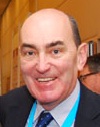It would be hard to find a more dramatic venue for an event addressing the issues and challenges of the Advance Techniques for Radio Transmitters event than the Howard Theatre of Downing College, Cambridge on 25 September. Painted scenes on the ceiling, columned architecture and theatre boxes provided a stunning back-drop to the latest Cambridge Wireless Radio Technology SIG event sponsored by CSR and Rohde & Schwarz. Centre stage and in the spotlight were six presenters who offered their perspective, thoughts and insight into transmit beamforming, full duplexing, envelope tracking and digital predistortion.
The first act (before the coffee break) saw Swaroop Venkatesh, Director, Systems Architecture, CSR consider: System-level implications of 802.11 Transmit Beamforming, where he provided an overview of 802.11 transmit beamforming technology, followed by an outline of its impact on the design of 802.11 PHY and MAC layers.
Alain Mourad, Wireless Specialist, InterDigital Europe Ltd looked at the: Potential of in-band full duplexing for future wireless systems. Against the background of recent advances in self-interference cancellation that have opened the door for in-band full duplexing to become a real disruptive technology candidate he offered an introduction to in-band full duplexing, highlighted its potential benefits and identified the challenges for future wireless systems. In the Q&A at the end of Mourad’s presentation a member of the audience quoted: Maximising RF Spectrum Utilization with Simultaneous Transmit and Receive by Charles H. Cox and Edward I, Ackerman of Photonic Systems Inc that appeared in the September issue of Microwave Journal, stimulating further discussion.
Taking a test and measurement perspective, Rainer Lenz, Product Manager, Rohde & Schwarz highlighted: Challenges for Power Amplifier Testing with Envelope Tracking - concepts, pit falls, state of the art and trends. He considered the basic concepts of envelope tracking, focusing on the challenges which evolve once the design needs to be tested against its specifications. He also gave a brief insight into what might be required in the future to keep pace with the latest trends in the wireless community.
After the interval the second act began with Jeremy Hendy, VP Marketing, Nujira, discussing: Envelope Tracking – fuel injection for the RF Front End, where he offered the analogy that envelope tracking equates to the introduction of fuel injection to vehicles in the 1970s, explaining how it overcomes the energy efficiency penalty introduced when transmitting advanced high data-rate waveforms with high PAPR, how it extends to MIMO systems, and how ET can ultimately enable single-chip CMOS integration.
In the first of two talks covering pre-distortion Chris Clifton, Chief Technology Officer & Technology Office Director, Sony SES, considered a: Programmable Wideband PA with Digital Pre-Distortion for High Efficiency – specifically a wideband PA (700-3800 MHz) PA which can be programmed digitally to meet the requirements for software defined radio architectures. A number of approaches for improving efficiency over the whole operating region were presented and discussed together with the use of simulation techniques.
The theme was continued by Richard Hewitt, Co-founder and CTO, Systems4Silico who talked about: Digital Pre-distortion – Transmitter System Engineering and Optimisation, where he addressed some of the key engineering decisions that face today’s transmitter system engineer when incorporating DPD and the challenges for DPD as transmit bandwidths increase.
A panel discussion with all six presenters on stage that provoked lively interaction with the audience brought the curtain down on the event.

